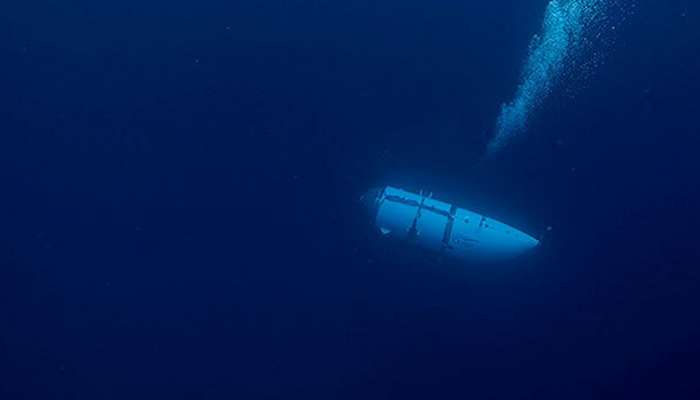
Newfoundland: Rescuers using sonar to search for the missing Titanic submersible with five people onboard detected underwater "banging" sounds in the North Atlantic where the craft vanished two days earlier, the US Coast Guard said on Twitter.
A Canadian aircraft detected underwater noises in the search area which led to the relocation of remotely operated vehicle's rescue operations "in an attempt to explore the origin of the noises," it said.
"Those ROV searches have yielded negative results but continue."
A Canadian aircraft involved in the search "heard banging sounds in the area every 30 minutes. Four hours later additional sonar was deployed and banging was still heard," said an internal email sent to US Department of Homeland Security officials, according to Rolling Stone magazine.
Broadcaster CNN also reported the detection of banging sounds, citing an internal US Government memo that did not clarify when the noises were heard Tuesday, for how long or what might have caused them.
This comes amid growing fears for the five people aboard, as the vessel only had enough oxygen for up to 96 hours when it set out on Sunday morning.
On Tuesday, Jamie Frederick of the US Coast Guard said the submarine had "about 40 hours of breathable air" left.
Who was on board?
Prominent Pakistani businessman Shahzada Dawood and his son, Suleman, were on board the vessel in the North Atlantic, their family said in a statement. Dawood is the vice chairman of one of the largest conglomerates in Pakistan, Engro Corporation, which has stakes in fertilizers, vehicle manufacturing, energy and digital technologies.
British billionaire Hamish Harding is also among the passengers, according to a social media post from a family member. Harding had earlier posted about his expedition on Instagram that he was proud to join OceanGate's Titanic mission.
"Due to the worst winter in Newfoundland in 40 years, this mission is likely to be the first and only manned mission to the Titanic in 2023," he wrote.
OceanGate's founder and CEO Stockton Rush was also later confirmed by the company to be on board.
Additionally, a French government source said that one of those on board was a French national — 77-year-old French explorer Paul-Henri Nargeolet.
Banging suggests use of submarine protocol
The banging noises at regular intervals bode well for the rescue efforts, submarine recovery expert Frank Owen told DW on Wednesday.
"The fact that these noises have been heard at regular 30 minute intervals suggests that the presence of the French former naval officer Paul-Henri Nargeolet has introduced the protocol that submarines would use if they were sunk," he said.
Owen explained that in the event of a sunk submarine protocol calls for crew members to make a noise on the hull for three minutes on the hour and half-hour marks. During these times, search personnel cease all transmissions and listen.
Owen said that the detection, made by sonar buoys, indicated that the rescue mission is being carried out in the right location.
"The fact that these noises have been heard by sonar buoys also lifts my spirits because it suggests that the sonar buoys are in the same water strata as the noise itself," he said, adding that it means that "the Titan may well be at or just slightly below the surface."
Even if the vessel were at the surface, time for a rescue would still be limited because the submersible's hatch cannot be opened from the inside.
Rescuing passengers a 'phenomenally difficult challenge'
The rescue mission is a "phenomenally difficult challenge," said Simon Boxall, an academic in oceanography at the University of Southampton.
Speaking to DW on Tuesday, Boxall said part of the challenge is the long distance between the submersible and the nearest coast.
Boxall explained that rescue teams could either use a sound radar to sweep the seafloor in an effort to locate the submersible or use cameras on unmanned vehicles. He said the latter was more feasible and therefore more likely.
"And, of course, once they've done that, they've still got the problem of how do they get it back to the surface. And, you know, this is fine if you've got months to do this. They've got two days to do this."
Speculating over what might have happened to the submersible, Boxall said it was likely immobilized and had lost its power. He speculated as a result that the vessel got caught on some of the wreckage in the seabed, or some of the fishing nets drifting about.
"No one knows. And until they can actually locate it and see it, then we've got no idea what the next stage will be."
Past warnings of safety problems
Court documents show that OceanGate was repeatedly warned that there might be catastrophic safety issues with the way it was developed.
David Lochridge, the company's director of marine operations, wrote a scathing engineering report in 2018 calling for more testing of the vessel. He warned that passengers might be endangered when it reached "extreme depths."
In the same year, OceanGate sued Lochridge for breaching a non-disclosure agreement, saying that he had shared details of the report with outsiders.
Court documents filed by Lochridge's lawyer show that he learned that the viewport of the vessel was only certified to work in depths of 1,300 meters. That is substantially less than required since the Titanic is nearly 4,000 meters below the ocean's surface.
A spokesperson for OceanGate said the missing sub was completed in 2020-21 so it was not the same as the vessel referenced in the lawsuit.
OceanGate received another warning in 2018 from the Marine Technology Society, which said it was critical that they submit its prototype to tests under a third-party expert before launching.